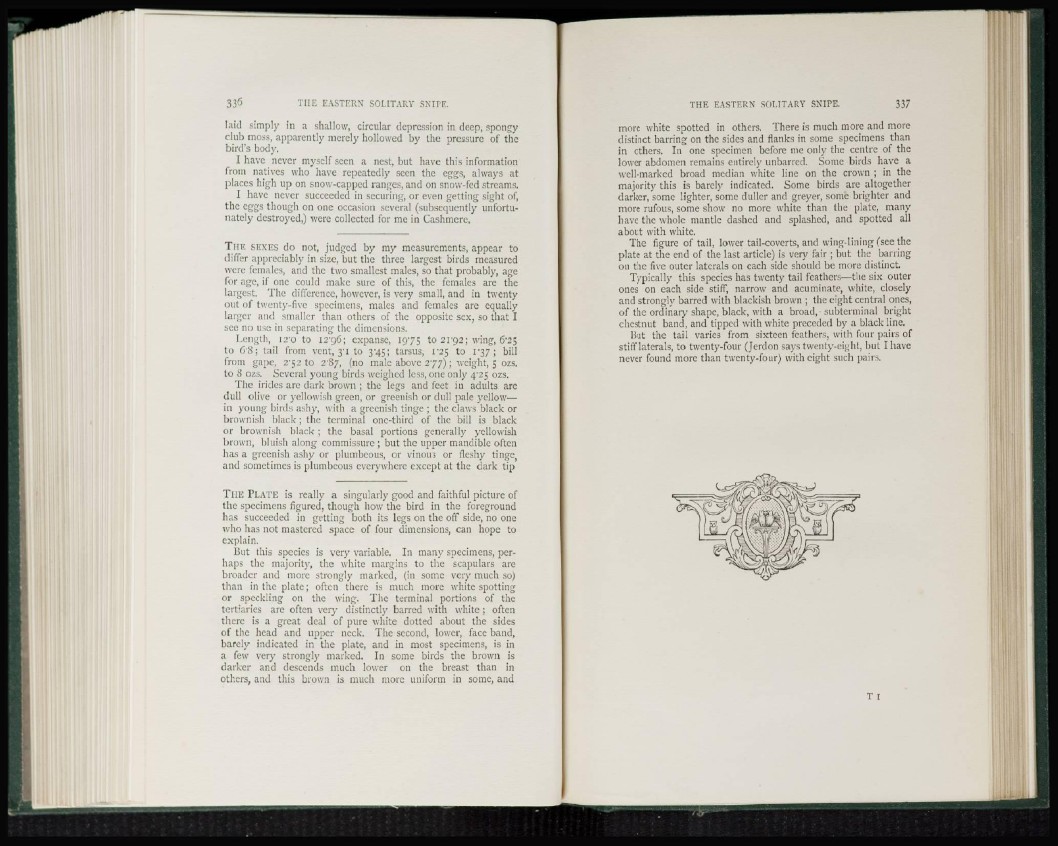
laid simply in a shallow, circular depression in deep, spongy
club moss, apparently merely hollowed by the pressure of the
bird's body.
I have never myself seen a nest, but have this information
from natives who have repeatedly seen the eggs, always at
places high up on snow-capped ranges, and on snow-fed streams.
I have never succeeded in securing, or even getting sight of,
the eggs though on one occasion several (subsequently unfortunately
destroyed,) were collected for me in Cashmere,
THE SEXES do not, judged by my measurements, appear to
differ appreciably in size, but the three largest birds measured
were females, and the two smallest males, so that probably, age
for age, if one could make sure of this, the females are the
largest The difference, however, is very small, and in twenty
out of twenty-five specimens, males and females are equally
larger and smaller than others of the opposite sex, so that I
see no use in separating the dimensions.
Length, 120 to 1296; expanse, 1975 to 21*92; wing, 6*25
to 6"8; tail from vent, 3'I to 3"45; tarsus, 1*25 to 1 "37 ; bill
from gape, 2^2 to 2-87, (no male above 277); weight, 5 ozs.
to S ozs. Several young birds weighed less, one only 4^25 ozs.
The irides are dark brown ; the legs and feet in adults arc
dull olive or yellowish green, or greenish or dull pale yellow—
in young birds ashy, with a greenish tinge ; the claws black or
brownish black ; the terminal one-third of the bill is black
or brownish black ; the basal portions generally yellowish
brown, bluish along commissure ; but the upper mandible often
has a greenish ashy or plumbeous, or vinoui or fleshy tinge5 and sometimes is plumbeous everywhere except at the dark tip
THE PLATE is really a singularly good and faithful picture of
the specimens figured, though how the bird in the foreground
has succeeded in getting both its legs on the off side, no one
who has not mastered space of four dimensions, can hope to
explain.
But this species is very variable, In many specimens, perhaps
the majority, the white margins to the scapulars are
broader and more strongly marked, (in some very much so)
than in the plate; often there is much more white spotting
or speckling on the wing. The terminal portions of the
tertiarics arc often very distinctly barred with white ; often
there is a great deal of pure white dotted about the sides
of the head and upper neck. The second, lower, face band,
barely indicated in the plate, and in most specimens, is in
a few very strongly marked. In some birds the brown is
darker and descends much lower on the breast than in
others, and this brown is much more uniform in some, and
more white spotted in others. There is much more and more
distinct barring on the sides and flanks in some specimens than
in others. In one specimen before me only the centre of the
lower abdomen remains entirely unbarred. Some birds have a
well-marked broad median white line on the crown ; in the
majority this is barely indicated. Some birds are altogether
darker, some lighter, some duller and greyer, some brighter and
more rufous, some show no more white than the plate, many
have the whole mantle dashed and splashed, and spotted all
about with white.
The figure of tail, lower tail-coverts, and wing-lining (see the
plate at the end of the last article) is very fair ; but the barring
on the five outer laterals on each side should be more distinct.
Typically this species has twenty tail feathers—the six outer
ones on each side stiff, narrow and acuminate, white, closely
and strongly barred with blackish brown ; the eight central ones,
of the ordinary shape, black, with a broad, subtermmal bright
chestnut band, and tipped with white preceded by a black line.
But the tail varies from sixteen feathers, with four pairs of
stiff laterals, to twenty-four (Jcrdon says twenty-ei^ht, but I have
never found more than twenty-four) with eight such pairs.
T I